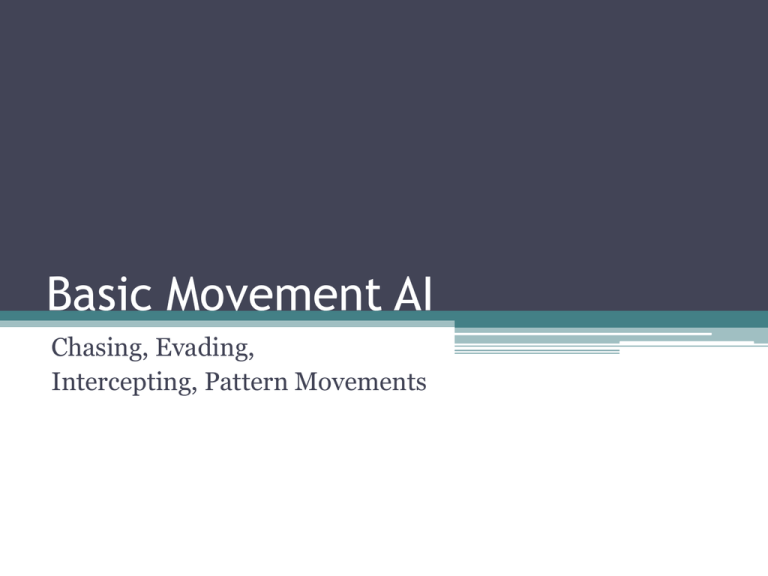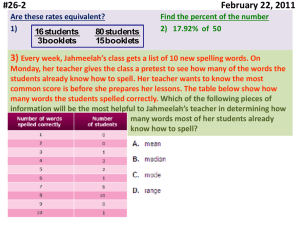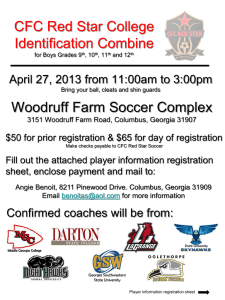Basic Movement
advertisement

Basic Movement AI
Chasing, Evading,
Intercepting, Pattern Movements
Movement AI
• Movement – Ubiquitous behavior found in many
games
• Chasing and Evading – the most basic
movement AI that can be implemented on NPCs
Chasing & Evading
• 2 parts
▫ Decision to initiate a chase or evade
▫ Effecting the chase or evade
• Sometimes, a 3rd part, to avoid obstacles while
chasing and evading is required, but that can be
considered separately
• 1st part – decision making
• Focus on 2nd part – concerns the action itself, to
chase and evade
Basic method
• Simplest method: Update NPC coordinates
through each game loop to
▫ Decrease the distance between NPC and player
(chase)
▫ Increase the distance between NPC and player
(evade)
• Pays no attention to NPC or player headings
(direction of travel) or speeds
More complex methods
• Positions and velocities (direction of travel) of
both NPC and player are considered so that NPC
can be moved to intercept the player instead of
relentless chasing
• In short: Predicting where the player will likely
to be at in the future, and moving towards that
as target
Basic Chasing
• Pseudocode for Chasing
if (npcX > playerX)
npcX--;
else if (npcX < playerX)
npcX++;
if (npcY > playerY)
npcY--;
else if (npcY < playerY)
npcY++;
Basic Evading
• Moving farther, instead of moving closer
• Pseudocode for Evading
if (npcX > playerX)
npcX++;
else if (npcX < playerX)
npcX--;
if (npcY > playerY)
npcY++;
else if (npcY < playerY)
npcY--;
Tile-based environment – How?
• 8-way movement
Tile-based Chase movement
• Updating difference
▫ Continuous environment: x, y coordinates in
Cartesian coordinate system (float)
▫ Tile-based environment: x, y in tile coordinate
system (int.) are columns and rows
if (npcCol > playerCol)
npcCol--;
else if (npcCol < playerCol)
npcCol++;
if (npcRow > playerRow)
npcRow--;
else if (npcRow < playerRow)
npcRow++;
Tile-based Chase – Any problem?
Line-of-sight Chasing
• Make NPC take a direct straight-line path
towards player
• Stationary player – straight path
• Moving player – path is not necessarily straight
Note may not look too bad if game loop
constantly updates position, path should appear
curved and natural
• Movements in TBE will appear less smoother
than CE due to coarse movement units
L-o-S Chasing in TBE
• Aesthetic disadvantage of using simple basic chase –
although no. of steps are the same
• Limitation of 8-way movement, no other possible angles
• Will look really BAD if many NPCs are chasing this way
L-o-S Chasing in TBE
• Solution: To calculate an intermediate path
(closest to a straight line) for the NPC to chase
• Use a standard line-drawing algorithm –
Bresenham’s algorithm
▫ Nice thing: Does not draw two adjacent pixels
along a line’s shortest axis
• Path calculation function
▫ Calculate and store a series of tiles to be moved to
▫ Needs to be called every time player changes
position
L-o-S Path in TBE
“Looking At” Rotation
• Without “Looking At” Rotation
(x1, y1)
• With “Looking At” Rotation
(x1, y1)
θ
(x2, y2)
• Only x and/or y are updated at
each time (8-direction)
(x2, y2)
• Additional rotation steers NPC
to look at target and chase in
that direction
Thrust and Steering forces
• Thrust force: pushes object to the front (velocity)
• Steering force: pushes the nose of object to the
right or left to rotate (angular velocity)
L-o-S Chasing in CE
• No need to determine path like in TBE,
movement updates are in floating-point
(rounding to nearest pixel integer gives good
approximation)
• Similarly, rotation angle (“looking at” direction)
should be re-calculated every time player
changes position
L-o-S Chasing in CE
• Curved path taken by predator when chasing prey
• What happens if the speed of the predator is set too fast?
Preventing overshooting
• Implement speed control logic to allow predator
to slow down as it gets closer to prey
▫ Calculate distance between both, if distance < some
predefined distance, reduce thrust velocity to slow down
L-o-S Evading
• Since we now understand L-o-S Chasing, L-o-S
Evading is just doing everything the reverse
• TBE
▫ Update movement in opposite direction (good
enough!)
• CE
▫ “Looking at” rotation should steer to opposite face
▫ Update movement in opposite direction
Further improvements?
• Acceleration (and deceleration) for thrust force
and steering force?
• Any way to improve “intelligence” of chasing
movement?
Intercepting
• Line-of-Sight Chase: NPC will always head directly
towards player
• In the case of a moving target, what happens?
Player
Line-of-sight Chase
NPC
Intercepting
• Movement can be more “intelligent”, if it knows how to
intercept the player somewhere along the player’s
“trajectory”.
• How do we work this out? What information do we
need?
Player
Line-of-sight Chase
NPC
Intercepting – In Principle
• Predict some “future” position of the player and
move towards that position, so that it reaches
the same time as player…
Player
Line-of-sight Chase
A “future”
position
of player
NPC
Intercepting Chase
Intercepting – A “Future” Position
• “Future” can be safely predicted linearly
• How to compute this position?
Player
Line-of-sight Chase
A “future”
position
of player
NPC
Intercepting Chase
Intercepting
• Important to consider relative velocities
(direction and magnitude) and distance instead
of just their current positions
• Let’s work out the math to determine what is the
predicted future position…
Intercepting - Code
• Recall: You would have implemented the Enemy
class already, and have it to chase the player.
Target Player position
• For Intercept, Target Player’s predicted future
position
▫ Easy to modify and adapt code from Chase to
Intercept
• Function to be called through the game loop to
constantly update interception point
Intercepting
Intercepting
• There are scenarios where intercepting may not
be possible or unrealistic
▫ NPC moving at much slower velocity
▫ NPC ends up chasing from behind a player moving
in straight line
▫ NPC gets ahead of player and moving at a faster
speed
Pattern Movement
• Simple way of giving the illusion of intelligent
behavior
• “Choreographed” movements of enemy NPCs
making organized maneuvers, loops
• Can be used effectively for
▫ Enemy NPCs (patrol, attack)
▫ Friendly NPCs (to exhibit or act intelligently to
cooperate with player)
▫ Secondary NPCs (doing all kinds of random
patterned actions)
Standard Pattern Movement
• Uses lists or arrays of encoded instructions to
tell NPC how and where to move each step
▫ Easy to loop through again
• Sample control data
ControlData {
double turnRight;
double turnLeft;
double stepForward;
double stepBackward;
};
Standard Pattern Movement
• Can include other kinds of actions:
▫ Fire weapon, release chaff, drop bomb, do
nothing, speed up, slow down, etc.
• Pattern initialization
▫ Hardcoded in game
▫ Loaded from a data file (text, XML)
• Process pattern
▫ Maintain and increment an index to the pattern
array through the game loop
Standard Pattern Movement
void GameLoop(void)
{ . . .
Object.orientation += Pattern[CurrentIndex].turnRight;
Object.orientation -= Pattern[CurrentIndex].turnLeft;
Object.x += Pattern[CurrentIndex].stepForward;
Object.x -= Pattern[CurrentIndex].stepBackward;
CurrentIndex++;
. . .
}
Pattern Movement in TBE
• Bresenham’s line drawing algorithm used again
to pre-calculate path steps
• More complex paths can be created by joining up
line segments
▫ Each new segment will begin once a previous one
ends
▫ Line-of-sight function End of segment now
assigned as the target
Pattern Movement in TBE
• Instead of resetting L-o-S path array, new line segment
is appended to previous path (Why do we do this?)
Pattern Movement in TBE
• High-level code for pattern initialization
entityList[1].InitializePathArrays();
entityList[1].BuildPathSegment(10, 3, 18, 3);
entityList[1].BuildPathSegment(18, 3, 18, 12);
entityList[1].BuildPathSegment(18, 12, 10, 12);
entityList[1].BuildPathSegment(10, 12, 10, 3);
entityList[1].NormalizePattern();
entityList[1].patternRowOffset = 5;
entityList[1].patternColOffset = 2;
Patrolling: Cyclical & Ping Pong
A
A
B
C
ABCBABCBA
D
B
C
ABCDABCD
Pattern Movement in TBE
• Ping Pong Patrolling
entityList[1].InitializePathArrays();
entityList[1].BuildPathSegment(10, 3, 18, 3);
entityList[1].BuildPathSegment(18, 3, 10, 3);
entityList[1].NormalizePattern();
entityList[1].patternRowOffset = 5;
entityList[1].patternColOffset = 2;
Pattern Movement in TBE
• To prevent repetition and predictability
Add a random factor for choosing alternative
patrolling path
How to implement?
Pattern Movement in PSE
• PSE – Physically Simulated Environments (or
Continuous Environments with Physics)
▫ You may specify positions for NPC to traverse, but
that defeats the purpose of using CE. Bad realism!
• Control structure needs to be designed to
accommodate forces (thrust, steering)
Pattern Movement in PSE
struct ControlData
{
bool PThrusterActive;
bool SThrusterActive;
double dHeadingLimit;
double dPositionLimit;
bool LimitHeadingChange;
bool LimitPositionChange;
};
• Changes in heading and position are relative in
patrolling
• Based on this control data, how do you initialize a square
pattern patrol?
Pattern Movement in PSE
• More implementation details can be found in textbook
Other Useful Movements
• Velocity Matching (for friendly NPCs, flocking)
• Wander (roaming NPCs)
(can be found in Millington’s book)







